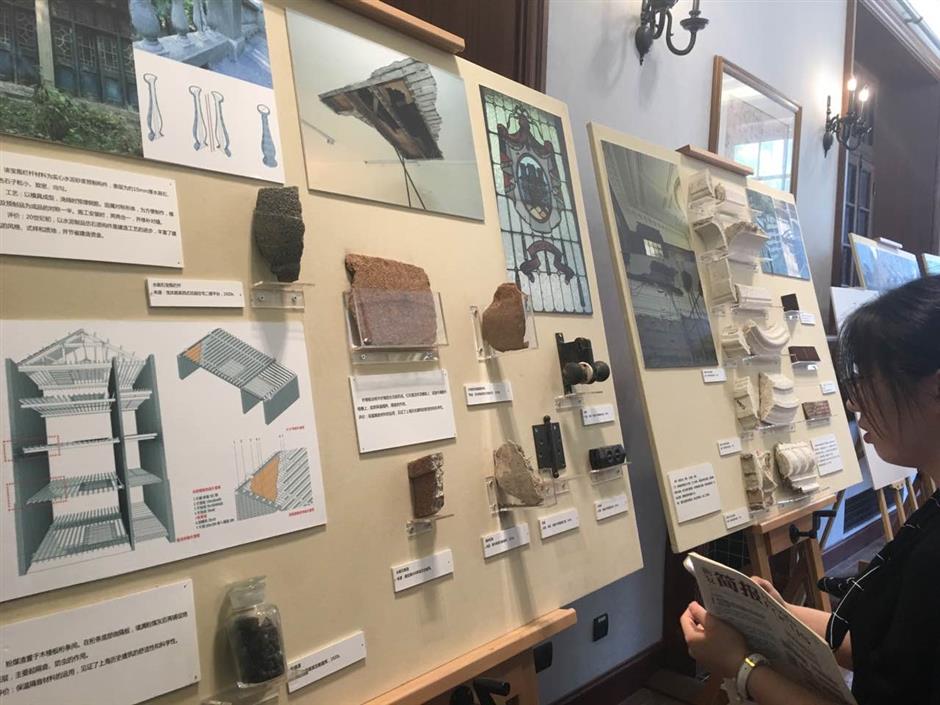Traditional house building skills to revive glory of historic streets

Xuhui District plans to renovate over 300 historic buildings in its Hengshan and Fuxing roads area by the end of the year with many original building skills and decorations to be revived, the district government said on Thursday.
The 342 buildings to be fixed and preserved include both historic protected structures and old residential buildings, covering a total of 221,000 square meters, according to the district's housing authority. Renovation projects have started on some 186,000 square meters of buildings.
To ensure the historic structures are properly restored, the district has collected and cataloged a number of traditional construction skills, many of which were brought to the city by Western architects early last century, said Jiang Jiang, deputy director with Xuhui housing management bureau.
"Those 'lost skills' have been reacquired through the demolishing campaign on some damaged houses as well as the years of preservation work on historic buildings," Jiang said.
A French-style tile, for instance, has been reconstructed and manufactured for many historic villas under renovation. The tile was widely used on the garden villas built in 1920s in the Hengshan-Fuxing Road Historic Reservation Area.
The rectangle-shaped tile is larger than local tiles, has two rainwater channels on the bottom and is made waterproof by simply placing it on the roof, Jiang said.
The tiles were initially imported from France and later manufactured in Wuhan City in central Hubei Province and transported to Shanghai. Xuhui district found some traditional brick manufacturers with ovens in neighboring Zhejiang and Jiangsu provinces to make the tile in the original style.
Cinder is being paved under the wooden floors of the historic villas as a traditional way to resist moisture and insects. The decoration materials on the shikumen, or stone-gate style buildings, have also been revived with multiply levels of stone and bricks, a traditional way to prevent cracks. Even the vase-shape rails on villa balconies have been restored with the original hollow structures, according to the bureau.
The bureau is displaying the skills and materials cataloged at an exhibition in the former Catholic seminary in Xujiahui.
Construction company officials taking charge of the renovation work are asked to study the skills displayed at the exhibition before starting their projects, Jiang said.
For protected buildings that have already been preserved, the government has made a detailed database for each building, including its size, inner structure, original designing charts as well as historic photos.
The Hengshan-Fuxing Road Historic Reservation Area has the largest number of well-preserved historic buildings and neighborhoods in the downtown area. The 4.3-square-kilometer area has over 1,600 historic buildings, mostly listed as protective structures, said Ru Guoming, director with the housing bureau.
The district government launched the major renovation work on the historic buildings in 2013 and is expected to finish the first round of overall preservation by the end of 2018, Ru said. A total of a million square meters of historic buildings will be fixed and restored to their original look by then.

Jiang Jiang, deputy director with the Xuhui housing management bureau, points to examples of traditional building skills.
"The major challenge is most of the historic buildings are still serving as residential houses with more residents using them than the buildings' original design capacity," said Wang Lin, a professor with Jiao Tong University who is taking charge of the renovation designs for the area. In many buildings, residents are still using shared bathrooms and kitchens.
The district government once launched a campaign to rearrange the inner structure and pipelines to build separate bathrooms for each household, but later found the project would damage the original structures, Jiang said.
The district government is working on a scheme to reduce the living density by relocating some residents to reduce the burden on the historic structures while improving the living standard of the remaining residents, Jiang added.
Meanwhile, the district has revived traditional bamboo spear fences on some streets of the historic area. The fencing, made of interlocked bamboo pieces, was once a common sight, but was gradually replaced by iron fences or walls.
"Pedestrians can look through the bamboo fences to enjoy the historic buildings and gardens behind the fences," Jiang said. "This historic memory of the city shall not be forgotten."















